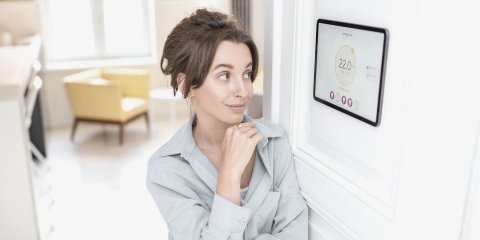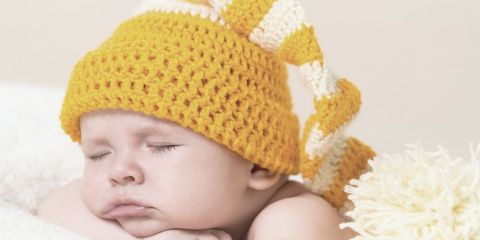Key Points
- Dress newborns with one extra layer to what you are wearing
- Never let babies sleep with headwear as it interferes with temperature regulation and can be a suffocation hazard
- Safe baby sleeping bags reduce the need for additional bedding in a cot or bassinet
Babies spend a lot of their time asleep, so it’s important you’re confident dressing them appropriately for sleep.
But, when it comes to babywear, it’s difficult to know where to start. After all, there’s just so much choice!
The most tempting items to buy as a new parent are often the most impractical. Once you’ve had bub for a few weeks, you’ll quickly realise what works and what doesn’t for easy nappy changes, a comfortable baby and no-fuss washing.
But, you shouldn’t have to wait until a few weeks in. We want to give you a headstart. So, for those of you wondering what babies should wear to sleep, we’re going to explain:
- How to tell if bub is too hot or cold
- The best clothes for bub to sleep in
- The rule about headwear
- The benefits of opting for natural fibres
- The importance of comfort
- When to swaddle
- When to use a baby sleeping bag
- Tips from Red Nose Australia on choosing sleepwear items
Is bub too hot or cold?
As a new parent, you might feel compelled to closely monitor room temperature to ensure bub is comfortable. After all, overheating (formally known as thermal stress) has been linked to SUDI (Sudden Unexpected Death in Infancy). On the other hand, when babies are cold they sleep poorly, but also fail to thrive as they burn more calories to stay warm. One study found a link between infants becoming more prone to respiratory infections in their first six months when they slept in environments which were slightly colder.

Despite this, Red Nose Australia generally doesn’t recommend a need for monitoring room temperature in Australia. Instead, you should dress bub according to the conditions.
The aim, when figuring out what babies should wear to sleep, is to keep them comfortably warm. And you can tell this by touch. The best way to tell whether bub is too hot or too cold is to feel the nape of her neck or her chest. When too hot, the nape of the neck and lower hairline gets noticeably sweaty. When cold, it is very obvious by the feel of the chest, or even back.
You might be wondering why you shouldn’t check the temperature of babies hands and feet? Well, babies' circulation is still developing, so even if these feel cool, it doesn’t mean that baby is too cold. In general, hands and feet are not good indicators of temperature.
What clothing should babies wear to sleep?
What clothing should babies wear to sleep? In general, you should dress your baby in similar layers to you. However, if bub is a newborn, you will likely need to add one additional layer to what you yourself would wear. This is because newborns have more difficulty regulating their temperature.
When it comes to clothing, it is best to use additional, thinner layers rather than one thick layer to keep bub warm. So, if you find you need to adjust what they're wearing in the night, it will be easy for you to add or remove a layer, rather than start over, or be tempted to leave them as is.
As for the type of clothing to wear, you can’t beat double-zippered onesies for bedtime, and you'll likely need to buy a bunch of them as its likely your baby will need to wear one for quite some time .
Onesies with snaps are ok but take longer to do up - and you want those middle of the night nappy changes to be as fast as possible! The double-zipper means you can just take bubs feet out for nappy changes and don’t have to leave their whole chest exposed. This helps babies of all ages stay warm in cold weather, but also maintain that all-important snug and secure feeling that newborns need.
Onesies are safer too. You might be tempted to buy “baby pyjamas”, but separates like loose tops can ride up over baby’s face and create a suffocation risk. Underneath a onesie, it’s easy to layer singlets and bodysuits accordingly. And of course, you can swaddle or add a sleep sack over the top.
For newborns and younger babies particularly, it helps to have onesies with foldable cuffs. Not only are your little one’s feet kept warm, but folding the cuffs over their hands like mittens means they can’t accidentally scratch their faces. These are a better choice than separate mittens which can fall off, or worse, become a suffocation hazard.
No headwear please
This is an important point when deciding what babies should wear to sleep - baby’s head should always be uncovered when sleeping. In fact, this is listed at number 2 on the Red Nose Australia list of baby safe sleeping products.

Why is this? Well, the head, and particularly the face, is how babies regulate their temperature. If their head is covered by a hat or beanie for example, they are unable to release excess heat. Additionally, headwear can also be a choking hazard if it comes loose while sleeping.
Why choose natural fibres?
What should babies wear to sleep? Fabrics that breathe.
Natural fibres are your best option because these allow moisture to evaporate. This is important because you don’t want baby to be too warm and sweat, and then proceed to get cold from being wet. 100% cotton is a top choice, or a cotton blend is next best. They are hardy and easy to clean. Cotton clothing is also soft and helps with temperature regulation.
It’s not only about what baby wears though. 100% organic cotton or bamboo bedding is important for helping bub stay comfortable, especially during our hot Australian summers.
The importance of comfortable baby sleepwear
Consider the huge changes in the environment a baby experiences at birth. They are released from the ultimate comfort of the womb into a world filled with different temperatures, sounds and sensations. And now, you need them to wear these strange things called clothes.
Some babies will be more sensitive to the feels of things and discomfort than others. But when choosing what babies should wear to sleep, we recommend following these basic guidelines:
- Sleepwear should be close-fitting, but not too tight so that it is restrictive.
- If opting for suits with feet, make sure they are long enough in the body that baby can completely stretch out.
- Well-finished and flat seams are important for eliminating irritation.
Traditional swaddling
When wondering “what should babies wear to sleep?”, you might consider swaddling. Traditional swaddling is an excellent way to settle babies and encourage them into sleep, particularly as newborns.
Because of the risk of them coming loose, traditional swaddles are best for when you’re actively monitoring your baby’s sleep, like during the day.
Once babies are showing signs that they are attempting to roll, swaddle use should be discontinued. And you should definitely stop using them by the sixth month. When swaddled babies roll onto their tummy, they are unable to turn back over and are at increased risk of SUDI.
If you choose to use a traditional swaddle, it is important that you follow the principles of safe wrapping:
- Use cotton or muslin only as other fabrics may cause overheating
- Wrap baby from below the neck
- Baby should be positioned on the back and with their feet at the bottom of the cot
- Swaddling should be firm enough not to loosen and cause a hazard, however not too tight so as to restrict hip and chest wall movement
- Baby should not be overdressed under the swaddle
- Never wrap baby if sharing a sleep surface
- Always combine swaddling with a safe sleep environment
Sleeping bags
Baby sleeping bags or sleep sacks can be used from birth, and are an alternative to traditional swaddling. In fact, the best ones are designed to have all the benefits of a swaddle, but without the risk of it unwrapping. Like a swaddle, these reduce the need for additional bedding in your baby’s bassinet or cot.
To be safe, a sleeping bag should have a fitted neck, fitted armholes or sleeves and no hood. They come in a range of sizes to suit the weight as well as the developmental stage of your little one.
Sleeping bags come with TOG ratings (Thermal Overall Grade) which indicates the level of insulation it provides. This is helpful, because you choose to use a sleeping bag with the appropriate TOG rating for the temperature of the room your baby is sleeping in. Lower-rated bags like 0.2 are designed for warmer weather, and higher ratings (up to 3.5) are designed for cold climates.
When you purchase a sleeping bag, the manufacturer will usually provide a guide for how to dress your baby underneath the sleeping bag, according to room temperature, which is extremely helpful.
There is some evidence to suggest that wearing a safe infant sleeping bag can even discourage and delay rolling in sleep.
Like swaddles, sleeping bags should allow infants to freely move their legs from the hips down.
According to Red Nose Australia, there is little evidence to suggest the use of one sleeping bag over another. What is most important is to choose a safe infant sleeping bag that is the correct fit for your baby and is also appropriate for their developmental stage.
Safety tips from Red Nose Australia
When you are making the decision to purchase or use any sleepwear items, Red Nose Australia recommends you ask yourself these four questions to assess the safety of those items:
“1. Is the product I am thinking of buying/using safe for my baby especially during sleep?
2. What are the potential benefits of using this product and what are the potential hazards?
3. Am I using the product in a safe way?
4. What is my baby/infant doing in this product, and does this create any potential hazards?”
You should never just assume the products you buy are safe, but make an assessment yourself for a decision that is right for your own family.
Now you have all the answers to your burning question, “What should babies wear to sleep?” And so we wish you and your little ones some sound sleep in the days to come!

